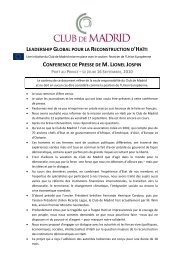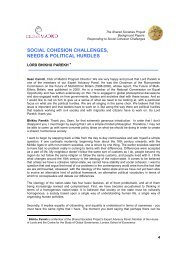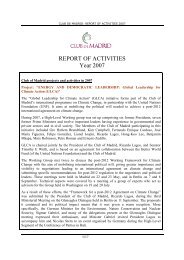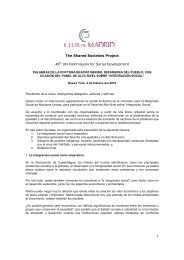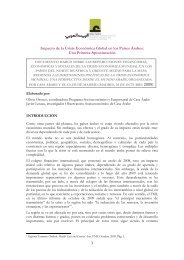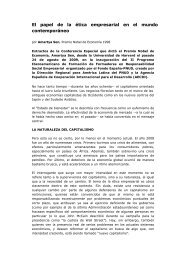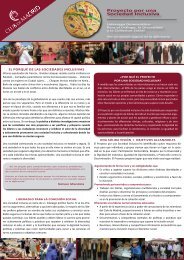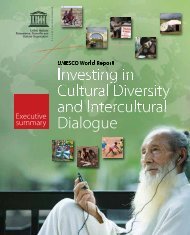Does Diversity Pay? - American Sociological Association
Does Diversity Pay? - American Sociological Association
Does Diversity Pay? - American Sociological Association
Create successful ePaper yourself
Turn your PDF publications into a flip-book with our unique Google optimized e-Paper software.
222—–AMERICAN SOCIOLOGICAL REVIEW<br />
are in the retail sector. Establishments in the<br />
manufacturing sector are more likely to have<br />
medium levels of racial (30 percent) and gender<br />
(33 percent) diversity than they are to have<br />
low racial (19 percent) or gender (28 percent)<br />
diversity or high racial (25 percent) or gender<br />
(17 percent) diversity.<br />
The table also indicates that there are regional<br />
differences in regard to various levels of racial<br />
diversity: 20 percent of organizations with low<br />
racial diversity are located in the Northeast,<br />
compared with 19 percent of those with medium<br />
levels and 9 percent with high levels. For<br />
gender diversity, 14 percent of organizations<br />
with low diversity, 12 percent of those with<br />
medium diversity, and 20 percent of those with<br />
high diversity are in the Northeast. More than<br />
one third (34 percent) of businesses with low<br />
levels of racial diversity are located in the<br />
Midwest, compared with 30 percent of those<br />
with medium levels and 14 percent of those<br />
with high levels. Twenty-two percent of businesses<br />
with low levels of racial diversity are<br />
located in the South, compared with 23 percent<br />
of those with medium levels and 37 percent<br />
of those with high levels. Nearly one quarter (24<br />
percent) of businesses with low levels of racial<br />
diversity are located in the West, compared with<br />
28 percent of those with medium levels and 39<br />
percent of those with high levels. The percentage<br />
of establishments located in the South (28<br />
percent) does not vary by level of gender diversity,<br />
and the percentage of establishments located<br />
in the West does not appear to be related<br />
systematically to level of gender diversity.<br />
REFERENCES<br />
Alon, Sigal and Marta Tienda. 2007. “<strong>Diversity</strong>,<br />
Opportunity, and the Shifting Meritocracy in<br />
Higher Education.” <strong>American</strong> <strong>Sociological</strong> Review<br />
72:487–511.<br />
Baron, James N. and William T. Bielby. 1980.<br />
“Bringing the Firm Back In: Stratification,<br />
Segmentation, and the Organization of Work.”<br />
<strong>American</strong> <strong>Sociological</strong> Review 45:737–65.<br />
Bell, Joyce M. and Douglas Hartmann. 2007.<br />
“<strong>Diversity</strong> in Everyday Discourse: The Cultural<br />
Ambiguities and Consequences of ‘Happy Talk.’”<br />
<strong>American</strong> <strong>Sociological</strong> Review 72(6):895–914.<br />
Berry, Ellen C. 2007. “The Ideology of <strong>Diversity</strong><br />
and the Distribution of Organizational Resources:<br />
Evidence from Three U.S. Field Sites.” Paper presented<br />
at the Annual Meeting of the <strong>American</strong><br />
<strong>Sociological</strong> <strong>Association</strong>, New York, New York.<br />
Black, Genie, Kevin Mason, and Gene Cole. 1996.<br />
“Consumer Preferences and Employment<br />
Discrimination.” International Advances in<br />
Economic Research 2:137–45.<br />
Blalock, Herbert M. 1957. “Percent Nonwhite and<br />
Discrimination in the South.” <strong>American</strong><br />
<strong>Sociological</strong> Review 22:677–282.<br />
Bratter, Jenifer and Tukufu Zuberi. 2001. “The<br />
Demography of Difference: Shifting Trends of<br />
Racial <strong>Diversity</strong> and Interracial Marriage,<br />
1960–1990.” Race and Society 4:133–48.<br />
Bunderson, J. Stuart and Kathleen M. Sutcliffe. 2002.<br />
“Comparing Alternative Conceptualizations of<br />
Functional <strong>Diversity</strong> in Management Teams:<br />
Process and Performance Effects.” Academy of<br />
Management Journal 45:875–93.<br />
Cohn, Samuel. 1985. The Process Of Occupational<br />
Sex-Typing: The Feminization Of Clerical Labor<br />
in Great Britain. Philadelphia, PA: Temple<br />
University Press.<br />
Cox, Taylor. 1993. Cultural <strong>Diversity</strong> in<br />
Organizations: Theory, Research, and Practice.<br />
San Francisco, CA: Berrett-Koehler.<br />
———. 2001. Creating the Multicultural<br />
Organization: A Strategy for Capturing the Power<br />
of <strong>Diversity</strong>. San Francisco, CA: Jossey-Bass.<br />
Cox, Taylor and Ruby L. Beale. 1997. Developing<br />
Competency to Manage <strong>Diversity</strong>. San Francisco,<br />
CA: Berrett-Koehler.<br />
Cox, Taylor H., Sharon A. Lobel, and Poppy Lauretta<br />
McLeod. 1991. “Effects of Ethnic Group Cultural<br />
Differences on Cooperative and Competitive<br />
Behavior on a Group Task.” Academy of<br />
Management Journal 34:827–47.<br />
DiMaggio, Paul and Walter Powell. 2003. “The Iron<br />
Cage Revisited: Institutional Isomorphism and<br />
Collective Rationality in Organizational Fields.”<br />
Pp. 243–53 in The Sociology of Organizations:<br />
Classic, Contemporary, and Critical Readings,<br />
edited by M. J. Handel. London, UK: Sage<br />
Publications.<br />
DiTomaso, Nancy, Corinne Post, and Rochelle Parks-<br />
Yancy. 2007. “Workforce <strong>Diversity</strong> and Inequality:<br />
Power, Status, and Numbers.” Annual Review of<br />
Sociology 33:473–501.<br />
Edelman, Lauren B. 1990. “Legal Environments and<br />
Organizational Governance: The Expansion of<br />
Due Process in the <strong>American</strong> Workplace.”<br />
<strong>American</strong> Journal of Sociology 95:1401–40.<br />
Embrick, David G. Forthcoming. “What is <strong>Diversity</strong>?<br />
Re-examining Multiculturalism, Affirmative<br />
Action, and the <strong>Diversity</strong> Ideology in Post-Civil<br />
Rights America.” Sociology Compass.<br />
Florida, Richard and Gary Gates. 2001. Technology<br />
and Tolerance: The Importance of <strong>Diversity</strong> to<br />
High-Technology Growth. Washington, DC: The<br />
Brookings Institution.<br />
———. 2002. “Technology and Tolerance:



